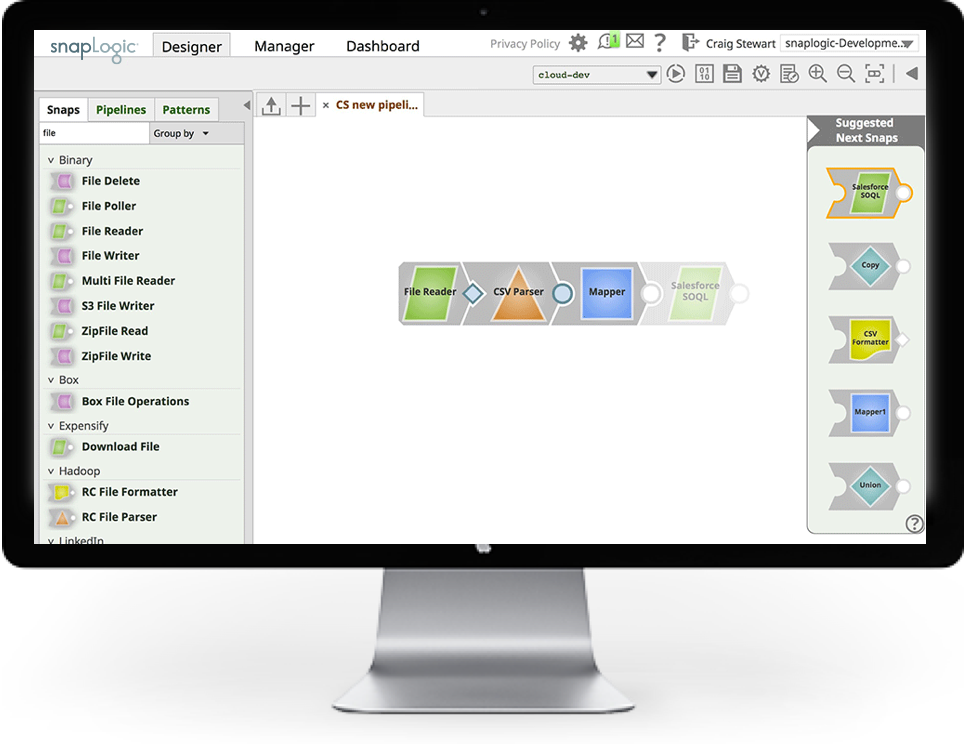SnapLogic, Maritz Optimize No-Code Integration for Employee Engagement, Customer Loyalty Programs
As cloud-based integration gets smarter and easier to use, it is driving next-gen business solutions, Maritz Motivation Solutions is using SnapLogic’s iPaaS for employee engagement and customer loyalty programs. IDN talks with SnapLogic’s Allen Lovett about the project – and how AI and self-service bring new power to iPaaS.
by Vance McCarthy
Tags: AI, citizen integrator, cloud, connectors, data pipelines, integration, iPaaS, machine learning, SaaS, Salesforce, SnapLogic, Workday,

senior vice president
"Self-service integration, with the promise of machine learning-powered innovations to come, was at the center of Maritz’s decision to choose SnapLogic."
Integration & APIs
 Enterprise-Grade Integration Across Cloud and On-Premise
Enterprise-Grade Integration Across Cloud and On-PremiseIn the latest sign that easy-to-use, cloud-based integration is driving next-gen business solutions, Maritz Motivation Solutions is leveraging the SnapLogic Enterprise Integration Cloud for its employee engagement and customer loyalty programs.
Under the Maritz / SnapLogic partnership, Maritz customers can take a no-code approach – to quickly add value to Maritz’ CultureNext and LoyaltyNext platforms by easily connecting them with valuable data from SaaS-based systems of record (notably Workday and Salesforce), Allen Lovett, SnapLogic’s senior vice president of global field operations, told IDN.
Crucial integrations between these systems can be achieved “without the need to write any integration code,” Lovett added. The under-the-hood, no-code integration capabilities are surfaced to non-technical end users via the SnapLogic Integration Assistant, with an intuitive UI and SnapLogic’s AI / machine learning component, dubbed ‘Iris.’
“Iris and the Integration Assistant will also help to get new (and more) Maritz users started and productive quickly with the SnapLogic platform - no training or IT involvement required,” Lovett said.
SnapLogic’s Integration Assistant approach with Iris also fills a big gap faced by Maritz and many other companies when it comes making it easier to gain value from their dispersed business data, he added.
SnapLogic, Maritz Enpowers ‘Citizen Integrators’ with Self-Service, Machine Learning
For all the promise of bringing big data and analytics, in the real-world it often proves complicated and difficult to implement and use solutions for non-IT professionals -- in HR, customer support and other departments. SnapLogic’s support for no code and low-hassle integrations provides a key for self-service – for both Maritz and its customers, Lovett said.
“Getting data out of those systems-of-records and into their Maritz platforms wasn’t always fast and easy. Until SnapLogic. . . Self-service integration, with the promise of machine learning-powered innovations to come, was at the center of Maritz’s decision to choose SnapLogic,” Lovett said.
“The majority of the assigned SnapLogic users are not experienced full-time developers and don’t know Java programming. Nor do they have the time or resources to engage IT on every new customer integration. So, they needed a simple, user-friendly, self-service platform to get new customers connected to the Maritz platforms quickly and easily,” Lovett said.

In specific, by adding SnapLogic’s cloud-based integration capabilities to CultureNext and LoyaltyNext platforms, Maritz can enpower non-technical ‘citizen integrator’ users with many key benefits. Among them:
- Greater real-time data access (and accuracy)
- More control and support for business-critical workflows between Maritz and other systems
- Enhanced ease-of-use with better security
- Easy integration with social networks
- Simplified IT management and support
Thanks to the combination of Maritz platforms and SnapLogic, users are “essentially ‘citizen integrators,’” Lovett said. “They required a self-service tool, so they could do the integrations themselves without IT support. They work with their customers directly to connect their Maritz platforms to Workday (for CultureNext) or Salesforce (for LoyaltyNext) to ensure a seamless free-flow of data between systems at all times.”
[A Gartner report released this spring, Citizen Integrators Bring Application and Data Integration Into a Common Focus, defined the ‘citizen integrator’ movement this way: As digitalization accelerates business transformation, business users are increasingly performing self-service tasks to integrate data and applications using iSaaS. (Integration Software as a Service)]
Maritz sells to more than half of the Fortune 500 to run employee rewards and/or customer loyalty programs. When Maritz start to work with a new customer, they need to connect their CultureNext platform (for employee rewards) or LoyaltyNext platform (for customer loyalty) to the respective systems-of-records at the customer organization. For employee rewards the system-of-record is often Workday, and for customer loyalty the system-of-record is often Salesforce.
“Getting these systems integrated in a timely manner, so they could get new employee reward and customer loyalty programs off the ground and productive ASAP, has become a competitive advantage for Maritz,” Lovett added.
Kimberly Lanier, Maritz vice president of employee engagement, noted the benefits SnapLogic is providing to CultureNext. “We’re very excited to be partnering with SnapLogic to ensure CultureNext is powered by real-time access to all workplace systems. This will benefit our customers in HR as they create and roll out programs designed to motivate and engage the workforce,” she said in a statement. It will also simplify operations and management for IT as well as create better end-user experiences for employees, she added.
“Only with connected, accurate, real-time data can you drive effective programs that drive a high-performance workplace.” Lovett added.
Earlier this year, SnapLogic CEO Gaurav Dhillon explained Iris and its approach to machine learning "Machine learning will power a self-service model for integration that’s important to the success of SaaS and analytics,” he said.
Inside SnapLogic’s Iris – Eliminating Integration Tasks with AI & Automation
Iris uses advanced algorithms to automate highly repetitive development tasks, eliminating integration backlogs that stifle most technology initiatives. Iris learns from millions of metadata elements and billions of data flows across SnapLogic’s cloud-based platform to determine what’s popular, what works, and what doesn’t work.
The idea is to shorten (even eliminate) the learning curve for line-of-business users to manage their own data flows, while freeing up technology teams for higher-value design and deployment needs.
Iris does its ‘learning’ as the algorithms sift through telltale data trails left behind from millions of customer integration tasks now successfully running in the SnapLogic Enterprise Integration Cloud iPaaS. Especially valuable to SnapLogic’s machine learning capabilities will be metadata elements and billions of data flows. Iris will also learn from failures, analyzing unsuccessful integration projects to diagnose what went wrong and help future users avoid those mistakes.
The result for the user: Iris machine learning is the engine powering SnapLogic’s first recommendation engine, called the SnapLogic Integration Assistant. It can deliver expert step-by-step guidance with up to 90 percent accuracy according to tests, Dhillon added.
“Fast time-to-market is priority #1 for Maritz, and self-service and ML-powered integrations [with Iris] will help them achieve this,” Lovett said. “It used to take Maritz months to complete new customer integrations which delayed the start of new reward and loyalty programs. Now with SnapLogic, it takes them just a matter of weeks or less. This fast time-to-market is a selling-point that is helping Maritz win new customer engagements.”
Related:
- Tray Advantage Program To Speed, Simplify AI-Powered Automation for Enterprises
- Removing Barriers to Business by Enabling Agility & Control with Ecosystem Integration
- 98% of Enterprises Struggle To Maintain, Rebuild Integrations for Key Business Apps
- ThreatX Adds API Visibility, Protection Capabilities To Defend Against Real-Time Attacks
- Visibility and Transparency are Climbing the List of C-Suite Priorities in 2022
All rights reserved © 2025 Enterprise Integration News, Inc.


